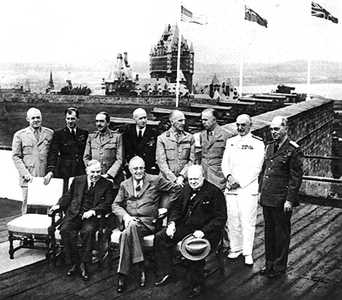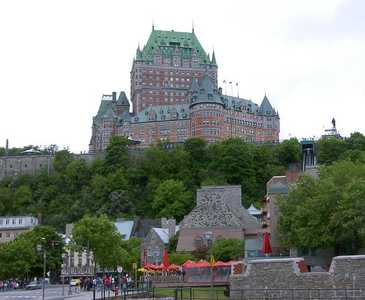Stalemate in Italy - Europe 1943
 |
 |
QUADRANT conference
- 1st Quebec Conference with FDR, Churchill, MacKenzie King- Aug. 17-24, 1943
- growing unity on military strategy, but also growing political disunity.
- Churchill wanted to continue full participation in the Manhattan Project, but FDR began to restrict British access; FDR and Churchill did agree not to share information with Stalin.
- Churchill agreed to central Pacific strategy of Nimitz (PAC-10), and to a U.S. command of OVERLORD.
- no Balkan invasion (never officially proposed by Churchill, but only to get Turkey into war, as a path into central Europe).
- Burma postponed.
- target date for defeat of Japan set at 1 year following defeat of Germany (Japan to be Oct. 1945).
- decision to invade Italy approved by CCS July 20, due to success of Sicily.
- 600,000 Allied troops & 150,000 airmen in Mediterranean - momentum important.
|
|
|
|
|
|
|
|
|
|
political problems:
- FDR & Churchill agreed to negotiate with Badoglio (image at right from ILN 1943/07/31) although violated Casablanca's "unconditional surrender" doctrine
- Italian Gen. Castellano met with Allies in Lisbon Aug. 19 - surrender signed Sept. 3 - co-belligerency accepted Oct. 13 - FDR agreed to Churchill's "long document" that kept the monarchy and Badoglio government for Italy
- Stalin angry at the Italian surrender & sought a tripartite commission to conduct allied negotiations on surrenders
- separate U.S.-British statements on De Gaulle - FDR opposed full recognition of a De Gaulle government, but Churchill sought some recogntion of De Gaulle's National Committee as a wartime ally.
Aug. 25 - Germany used the Hs 293 glider bomb for the first time in the Battle of the Atlantic against anti-sub ship in Bay of Biscay, and succeeded Aug. 27 in using it to sink the HMS Egret. The glider bomb was one of Germany's secret weapons that included the V-1 being developed at Peenemunde that was bombed by the British August 17, 1943.
Aug. 26 - FDR and Churchill granted limited recognition to De Gaulle's FCNL.
Aug. 28 - German Gen. von Hanneken dissolved the Danish government and occupied Denmark
Sep. 8 - FDR announced Italian surrender in his Fireside Chat and the Italian fleet with 3 battleships, 6 cruisers, 9 destroyers sailed for Malta.
AVALANCHE
- Sir Harold Alexander commanded 15th Army Group (included British 8th Army and American 5th Army)
- Invasion of Italy began Sep. 3 with British landings at Calabria led by Montgomery, Sept 9 with British landings at Taranto, and Sep. 9 with U.S. 5th Army landings at Salerno led by Mark Clark (at age 46 was America's youngest 3-star general)
- 16 German divisions in Italy (6 from East): Rommel in north (wanted Pisa-Rimini line); Kesselring in south (wanted Volturno line); Ultra had indicated Germany would not fight below Rome, but Hitler changed his mind
|
|
|
|
|
Sep. 9 - Salerno - 3 phases:
|
|
|
|
|
|
|
|
|
|
|
|
- landings (Sep 9), reinforcement (Sep 10-13); counterattack (Sep 12-16)
- broad 36-mile landing, divided by Sele River (mistake - should have landed north of river)
- all to converge at Ponte Sele, 12 miles inland
- met intense German machine gun and artillery fire, panzers from hills, 625 Luftwaffe
- only 4 U.S. divisions vs. most Kesselring's German divisions, his opposition was unexpected
Sep. 12 - German von Vietinghoff found gap in Allied line
- attacked down Sele Corridor Sep. 13
- Clark's personal leadership at front lines, like Civil War general
- Germans did not like night attacks, allowed U.S. reinforcements, especially 2100 from Gavin's 505th Parachute Regiment of the 82nd Airborne Divison
- gap closed by Sep 16 - 504th Parachute Regiment took Altavilla
- Ike fired Gen. Ernest Dawley of 6th Corps
Sep. 16 - Kesselring retreated to Volturno River
- 20 miles north of the Naples that he had destroyed
- mined harbor, began construction of defense lines
- Barbara, Reinhard, and primary Gustav lines
- lowlands of Rapido flooded, Cassino fortified
Sep. 21 - Allied advance on Rome began
- ULTRA discovered that Hitler now intended to defend Rome, but Alexander ordered advance on Rome anyway
- U.S. 5th Army advance was slow, 1.5 miles per day in rain and mud
Sep. 27 - Foggia taken
- became major air base, attack on Ploesti in Rumania Aug. 1
- but Foggia diverted supplies from Clark's 5th Army - 300,000 tons
Oct. 1 - STRANGLE emphasized air power
- Allies able to achieve air superiority, began to interdict German supply routes
- but no direct tactical air support for 5th Army
- also, Germans ran trains at night that were loaded outside of Italy, kept bridges repaired
Oct. 1 - Naples occupied
- although had been destroyed, became miracle of engineering reconstruction
- opened to 20,000 tons per day
Oct. 2 - Termoli attack begins
- Hitler ordered Kesselring to stand, reinforce and fight
- 25 German divisions faced 11 Allied divisions by Nov. 1
- only advance up Route 6 feasible to Rome
- but no additional supplies - would mean frontal assaults
Oct. 12 - Volturno crossed
- Kesselring retreated to Barbara Line
- fortified hills (no trees - clear artillery view)
Nov. 4 - start of attack on Reinhard line near Mignano
- but slowed by stiff resistance, bad weather
Nov. 15 - advance is halted at the Sangro
- Winter Position occupied by Allies
- between Volturno & Gustav Lines
- becomes a "prepared killing ground"
- most difficult and heartbreaking time of Italian campaign
Dec. 2 - attack on peaks of La Difensa & La Rematanea
- newly arrived 2nd Corps under Gen. Keyes
- but mountain war is slow and costly
- German bombers attack Bari, ammunition ship exploded, 18 transports sunk and 38,000 tons supplies destroyed
Dec. 7 - attack on San Pietro failed
Teheran Conference Nov. 27-Dec. 1